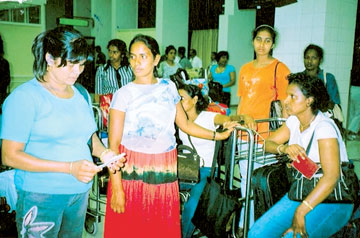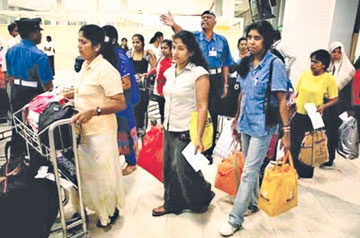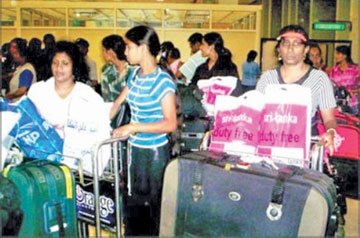New trends, old concerns
Migration management is in the spotlight:
1.8 million Sri Lankans are currently working abroad:
“Action Plan” on the return and reintegration of
migrant workers:
Bilateral agreement ensures a standard contract:
Vast majority, women:
With a boom in the construction industry in the Middle East since
2012, Sri Lanka appears to have changed its migration trend- and was
sending more men than women.
Changing trends apart, some of the issues, though addressed from time
to time, still remain.
 With nearly two million Sri Lankans working abroad and their
remittances forming the largest source of foreign exchange to the island
nation, Sri Lanka’s migration management is in the spotlight at present. With nearly two million Sri Lankans working abroad and their
remittances forming the largest source of foreign exchange to the island
nation, Sri Lanka’s migration management is in the spotlight at present.
A new national migration policy has already been issued under which
several aspects, authorities say, have been addressed. There is a new
“Action Plan” on the return and reintegration of migrant workers, an
aspect that had received little attention for years.
In an exclusive interview, UN Special Rapporteur on Human Rights of
Migrants, Francois Crepeau, called upon the Sri Lankan Government to
ensure safety of the entire migration process, specially in the backdrop
that migrant workers remained the island's key source of income and
deserved much better socio-legal protection.
According to the latest statistics from the Sri Lanka Bureau of
Foreign Employment(SLBFE), approximately 1.8 million Sri Lankans are
currently working abroad – the vast majority of them women, employed as
domestic workers and care givers primarily in Saudi Arabia, Qatar, UAE,
Kuwait and Lebanon.
Remittances remain the key foreign exchange earning source for the
island and the key source of dependency for one third of the country's
population.
In 2013, foreign remittances remained the largest source of foreign
exchange into the island, amounting to Rs. 827,689 million (US$ 6.4
billion, according to the Annual Statistical Report of Foreign
Employment 2013.
Safety issues
Some of the old concerns die hard, though. According to Crepeau,
physical and work safety issues of Sri Lankan migrant workers,
socio-economic conditions that compelled ethnic minority Tamils to take
risky boat rides as asylum seekers/illegal migrants at a particular
time, reflected serious legal, labour and humanitarian concerns.
 “Issues of safety, abuse, exploitation and harassment continue to
plague Sri Lankan migrant workers. As a country reliant on the export of
labour, authorities should urgently address them,” he said. “Issues of safety, abuse, exploitation and harassment continue to
plague Sri Lankan migrant workers. As a country reliant on the export of
labour, authorities should urgently address them,” he said.
Referring to a common problem faced by labour exporting countries –
Physical safety of migrant workers – Crepeau urged performance of
autopsies on Sri Lankan migrant workers who die aboard.
“There had been reports of mutilated bodies being returned to Sri
Lanka, at times, with missing organs. Autopsies are not performed in Sri
Lanka and the families are often not allowed to see these bodies,” he
noted, making reference to his interim report issued last year.
In 2013, there were 298 migrant worker deaths, an increase by 3.8
percent from 2012. The value of insurance paid to migrant worker
families totalled Rs. 130,515,977 (US$1,011,751).
As several other labour exporting nations, Sri Lanka too exports more
women as migrant workers than men, a trend reversed since 2012. While
the construction boom is considered the primary reason for this altered
pattern, there are policy decisions that many consider, as contributors
to the reverse order.
One such is the requirement of a a Family Background Report (FBR)
since 2014, a decision that is possibly linked to the execution of a Sri
Lankan housemaid in Saudi Arabia in 2012, Rizana Nafeek.
According to the new stipulation, women with children under five
years are not recommended for migrant work, which Crepeau has called a
violation of human rights, depriving opportunities for improving home
economy.
Migration of women for foreign employment remained largely steady
from 1995-2012, but declined in 2013, by a significant 40.3 % with a
rapid increase in men’s migration, mostly as construction workers.
“Women migrants often work in private households, making them
particularly vulnerable to abuse and exploitation. Domestic work is
excluded from most of the labour laws in many countries, including in
Sri Lanka. Sri Lanka should extend labour protection to domestic
workers, ratify the relevant ILO Convention 189 on Decent Work for
Domestic Workers,” said Crepeau.
Despite a decline in recruitment in 2013, 82% of those Sri Lankan
women recruits went as domestic housekeeping assistants, according to
the draft Annual Statistical Report of Foreign Employment 2013.
Protection of workers
 There had been recorded instances of serious rights violations
including torture, abuse, assault and even sexual assaults, in addition
to exploitative labour practices such as substitution of contracts
though which wages are reduced and job description altered. There had been recorded instances of serious rights violations
including torture, abuse, assault and even sexual assaults, in addition
to exploitative labour practices such as substitution of contracts
though which wages are reduced and job description altered.
The plight of the domestic workers was highlighted best when Rizana
Nafeek was executed but there had been equally painful examples before.
The SLBFE acknowledges corruption, despite measures to ensure safe
migration, and agree that substitution of contracts after migrant
workers reach their workplaces still takes place, though the numbers
have reduced.
“We are trying to further reduce these concerns. We hope to enter
bilateral agreements with labour receiving countries to ensure workers’
rights better,” said Indrani Pathinayake, Assistant General Manger,
Training and Recruitment, Sri Lanka Bureau of Foreign Employment (SLBFE).
Sri Lanka has such an agreement only with Saudi Arabia at present.
The bilateral agreement ensures a standard contract which guarantees
internationally accepted rights of workers, generally denied in most
countries, to domestic workers.
It also prevents substitution of contracts, a recurring problem, in
the destination state.
Crepeau on the other hand proposes the negotiation of similar
agreements with other destination states, in line with international
human rights instruments and their effective implementation.
Meanwhile, Sri Lanka has begun strengthening its legal framework and
shifted focus from female to male migrant workers with emphasis falling
on skilled workers.
The Sri Lankan Government has made training compulsory for all
migrant workers and for the domestic sector, which is 95% women
employed, there is a specific vocational training skills level to be
achieved, together with language competency.
A National Policy on Reintegration of Migrant Returnees and a
National Acton Plan are to be soon introduced, delayed by the
presidential election that concluded in January. The new policy looks at
socio- economic and psychological reintegration of migrant returnees.
A Safe Labour Migration Guide has been introduced to educate
prospective migrants on safe migration.
Undocumented migration
Following the end of the war between Sri Lankan Security Forces and
the Liberation Tigers of Tamil Eelam (LTTE) in May 2009, there had been
an increase in ethnic Tamils from fleeing the island in boats, mostly to
Australia, from the island’s north and east.
There had been concerns about racial discrimination, lack of
employment opportunities and a sense of hopelessness driving young Tamil
men in particular; to take risky boat rides to Australia and other
destinations, seeking safety and employment.
Crepeau's interim report stated: “Information is now available,
indicating that Tamils experience a particular need to migrate, often
without documents, due to poor employment opportunities in Sri Lanka and
discrimination. The Sri Lankan Government should take effective measures
to ensure equal work opportunities for all Sri Lankans, making migration
a choice, not a necessity.”
“Some Sri Lankans try to migrate irregularly to Australia on boats,
often facilitated by smugglers. Attempting to migrate irregularly is a
criminal offence in Sri Lanka. I urge the Government to decriminalize
irregular migration as it should only be considered an administrative
offence.”
|

